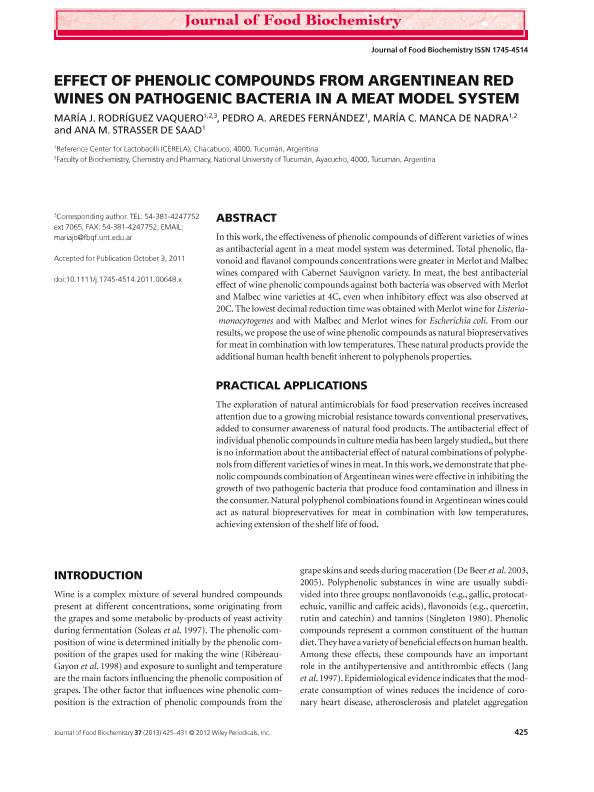Mostrar el registro sencillo del ítem
dc.contributor.author
Rodriguez Vaquero, Maria Jose

dc.contributor.author
Aredes Fernández, Pedro Adrián

dc.contributor.author
Manca, Maria Cristina

dc.contributor.author
Strasser de Saad, Ana Maria

dc.date.available
2015-10-08T17:30:44Z
dc.date.issued
2013-08
dc.identifier.citation
Rodriguez Vaquero, Maria Jose; Aredes Fernández, Pedro Adrián; Manca, Maria Cristina; Strasser de Saad, Ana Maria; Effect of phenolic compounds from Argentinean red wines on pathogenic bacteria in a meat model system; Wiley; Journal Of Food Biochemistry; 37; 4; 8-2013; 425-431
dc.identifier.issn
0145-8884
dc.identifier.uri
http://hdl.handle.net/11336/2412
dc.description.abstract
In this work, the effectiveness of phenolic compounds of different varieties of wines as antibacterial agent in a meat model system was determined. Total phenolic, flavonoid and flavanol compounds concentrations were greater inMerlot andMalbec wines compared with Cabernet Sauvignon variety. In meat, the best antibacterial effect of wine phenolic compounds against both bacteria was observed withMerlot and Malbec wine varieties at 4C, even when inhibitory effect was also observed at 20C. The lowest decimal reduction time was obtained withMerlot wine for Listeriamonocytogenes and with Malbec and Merlot wines for Escherichia coli. From our results,we propose the use of wine phenolic compounds as natural biopreservatives for meat in combination with low temperatures. These natural products provide the additional human health benefit inherent to polyphenols properties. The exploration of natural antimicrobials for food preservation receives increased attention due to a growing microbial resistance towards conventional preservatives, added to consumer awareness of natural food products. The antibacterial effect of individual phenolic compounds in culturemedia has been largely studied,, but there is no information about the antibacterial effect of natural combinations of polyphenols fromdifferent varieties of wines in meat. In thiswork,we demonstrate that phenolic compounds combination of Argentinean wines were effective in inhibiting the growth of two pathogenic bacteria that produce food contamination and illness in the consumer.Natural polyphenol combinations found in Argentinean wines could act as natural biopreservatives for meat in combination with low temperatures, achieving extension of the shelf life of food.
dc.format
application/pdf
dc.language.iso
eng
dc.publisher
Wiley

dc.rights
info:eu-repo/semantics/openAccess
dc.rights.uri
https://creativecommons.org/licenses/by-nc-sa/2.5/ar/
dc.subject
Phenolic Compounds
dc.subject
Red Wine
dc.subject
Antimicrobial Activity
dc.subject
Pathogenic Bacteria
dc.subject.classification
Biotecnología Agrícola y Biotecnología Alimentaria

dc.subject.classification
Biotecnología Agropecuaria

dc.subject.classification
CIENCIAS AGRÍCOLAS

dc.title
Effect of phenolic compounds from Argentinean red wines on pathogenic bacteria in a meat model system
dc.type
info:eu-repo/semantics/article
dc.type
info:ar-repo/semantics/artículo
dc.type
info:eu-repo/semantics/publishedVersion
dc.date.updated
2016-03-30 10:35:44.97925-03
dc.journal.volume
37
dc.journal.number
4
dc.journal.pagination
425-431
dc.journal.pais
Estados Unidos

dc.description.fil
Fil: Rodriguez Vaquero, Maria Jose. Consejo Nacional de Investigaciones Científicas y Técnicas. Centro Científico Tecnológico Tucumán. Centro de Referencia para Lactobacilos (i); Argentina. Universidad Nacional de Tucuman. Facultad de Bioquimica, Quimica y Farmacia. Instituto de Microbiologia;
dc.description.fil
Fil: Aredes Fernández, Pedro Adrián. Consejo Nacional de Investigaciones Científicas y Técnicas. Centro Científico Tecnológico Tucumán. Centro de Referencia para Lactobacilos (i); Argentina
dc.description.fil
Fil: Manca, Maria Cristina. Consejo Nacional de Investigaciones Científicas y Técnicas. Centro Científico Tecnológico Tucumán. Centro de Referencia para Lactobacilos (i); Argentina. Universidad Nacional de Tucuman. Facultad de Bioquimica, Quimica y Farmacia. Instituto de Microbiologia;
dc.description.fil
Fil: Strasser de Saad, Ana Maria. Universidad Nacional de Tucuman. Facultad de Bioquimica, Quimica y Farmacia. Instituto de Microbiologia; . Consejo Nacional de Investigaciones Científicas y Técnicas; Argentina
dc.journal.title
Journal Of Food Biochemistry

dc.relation.alternativeid
info:eu-repo/semantics/altIdentifier/url/http://onlinelibrary.wiley.com/doi/10.1111/j.1745-4514.2011.00648.x/abstract
dc.relation.alternativeid
info:eu-repo/semantics/altIdentifier/doi/http://dx.doi.org/10.1111/j.1745-4514.2011.00648.x
dc.relation.alternativeid
info:eu-repo/semantics/altIdentifier/url/http://onlinelibrary.wiley.com/journal/10.1111/(ISSN)1745-4514
Archivos asociados
